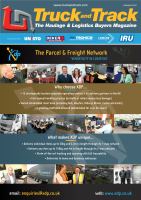

Truck and Track
June/July 2017
www.truckandtrack.com48
SAFETY & SECURITY
“
We are seeing an increasing use of CCTV in refrigerated vehicles
over and above that commonly used elsewhere in the world of
logistics. Indeed there are various reasons why this should be
the case.
As regards Health and Safety, operators want to be certain that
their employees are following company procedures when working
in chilled and frozen areas. Given the low temperatures, the
potential for slips and trips is increased, and obviously workers
should be shown to be wearing the appropriate personal protective
equipment (PPE) when carrying out tasks in that environment.
There is also a maximum exposure time for operatives in low
temperature conditions, and compliance can be monitored using
CCTV. At amore general Health and Safety level, logistics companies
need to ensure that employees are using the correct lifting
techniques and manual handling equipment appropriate to their
loading and unloading procedures.
Frozen or chilled produce is often of high value and can be easily
damaged in transit if not stored or loaded correctly. Operators are
increasingly taking proactive measures to ensure that produce
is delivered in prime condition. To avoid potential issues with
customers, CCTV footage can be used to verify that produce has
been offloaded from a vehicle in good condition, or not as the case
may be.
Finally, the CCTV system can be used to check that employees are
not deliberately damaging produce or falsely claiming that produce
has been damaged and are not stealing from or defrauding the
company.
The CCTV system for cold chain applications is similar to more
standard systems, apart fromthe need to fit special heated cameras
in the chilled or frozen section.
You often need to use more cameras, since loading and unloading
are often undertaken via a side or rear door, and there can be
movablebulkheaddividersthatallowtheloadareatobepartitioned
into different configurations. These variables mean that you would
require more cameras than first thought, in order to provide the
necessary visual coverage of internal and external work areas.
Hardware-wise, standard cameras will work down to the
temperature range that frozen containers are run at, typically
-8° to -25°C dependent upon produce. Nevertheless, at those
temperatures the camera lens will ice over. Therefore, for use inside
chilled or frozen containers, Vision UK supplies cameras with built-
in heaters which ensure that the lens remains frost-free.
An added complication is that a camera must not be allowed to
totally freeze over, as otherwise it takes too long to defrost the lens,
and the camera would be out-of-action for lengthy periods. So
typically, in frozen bodies (not necessarily in chilled environments),
the cameras are permanently powered up – or the system is
operated on a timer so that the cameras can be operated as and
when required.
For details of Vision UK’s innovative solutions for CCTV monitoring
on refrigerated vehicles, call 0800 731 3316 or go to the website
www.vision-uk.co.uk.Rick Treharne, Managing Director of the Cheshire-based CCTV solutions provider Vision UK, shares
with readers his knowledge and experience of monitoring in the special environment of refrigerated
transport
Keeping a close eye on
cold chain vehicles
”



















